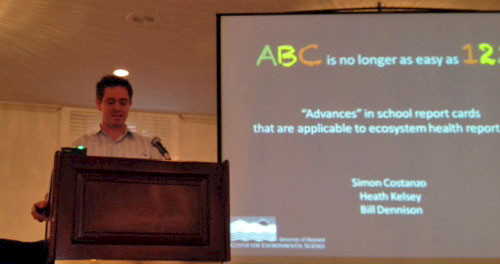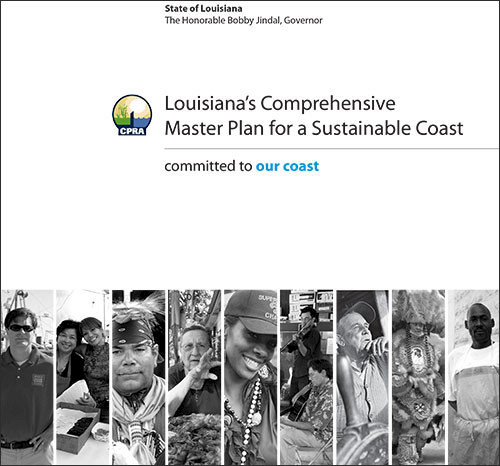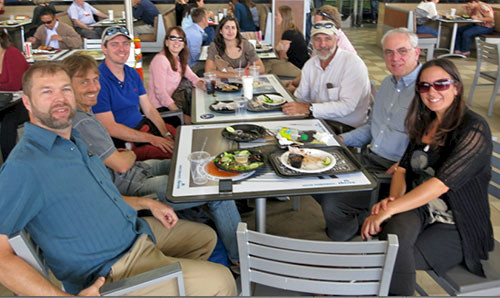Discussing science communication at CERF2013
Bill Dennison ·We had a large contingent of IAN folks attend the 22nd Biennial Conference of the Coastal and Estuarine Research Federation conference in San Diego, California. The conference was titled "Toward resilient coasts and estuaries, science for sustainable solutions". Bill Nuttle, Health Kelsey, Caroline Wicks and I co-chaired a session "Science communication strategies for ecosystem-based management".

After arriving directly from Turkey late on a Monday night, I was the first talk at 8:00 am on Tuesday morning. I headed out early to register for the conference, upload my PowerPoint at the conference computer center and venture out to find the building a room where my session was scheduled. A nice graduate student walked me to the right building within the Town and Country Conference Center. I found the room where our session was to be held in plenty of time and decided to go in search of coffee. After finding coffee, I struggled to relocate my conference room and was almost late for my own talk! Even after several days at this conference venue, I still ended up wandering around looking for various conference rooms, but the outdoor walks with paths lined with roses were a nice break.
My talk was titled "Effective science communication strategies to address climate change, environmental management and resource assessment". I started off by saying that various science communication strategies including printed materials (e.g., newsletters, booklets and books), electronic media (e.g., website, apps and social media), and in person events (e.g., presentations, meetings and workshops) that have been used to communicate topical issues like climate change, environmental management and resource assessment. I illustrated these points with various IAN Press examples, and emerging technologies (e.g., apps, YouTube videos, eBooks). I concluded with the following reflections on science communication: 1) there are many different ways to communicate science effectively, 2) a team approach is useful for brainstorming, 3) scientific synthesis is a part of science communication, 4) there is an increasing recognition of the importance of effective communication and 5) the delivery mechanisms continue to evolve, but basic principles remain.
Caroline Wicks made a nice presentation about communicating Chesapeake Bay science and management. She identified a science communication strategy process: 1) Define your message, 2) Analyze your target audiences, 3) Define your goals, 4) Explore outlets, 5) Create a time frame, 6) Identify ways for feedback, 7) Get approval and 8) Implement strategy. Caroline also identified some of the challenges of a multi-state, multi-partnership communication strategy, including conflicting messages, regulation vs. management perspectives, complexity of scientific issues and report card 'fatigue' (repeated bad grades without measurable improvement). I liked her reflections on the evolution of Chesapeake Bay communication, within the context of an adaptive management strategy.
Simon Costanzo made a thought-provoking presentation with the title: "ABC is no longer as easy as 123: Advances in school report cards that are applicable to ecological health report cards". He provided a historical perspective of educational report cards, dating back to Henry David Thoreau getting points at Harvard University to pass/fail checkmarks, to alphabetic grades in the 1940s to the current standards based testing and reporting. Simon identified various report card features that environmental report cards should aspire to, based on lessons from educational report cards.

Gabriela Munoz talked about developing a New York/New Jersey Harbor report card, highlighting their State of the Estuary 2012 report, a nice 32 pp. synthetic document. Kate Boicourt was a co-author on this report and I could see some of the good science communication principles that Kate developed as a Science Communicator with the Integration and Application Network implemented in the State of the Estuary 2012 report.

Bob Virnstein, a retired seagrass colleague, who has been studying the Indian River lagoon on Florida's east coast for many decades talked about how seagrasses were able to withstand direct hurricane strikes, but did not withstand a recent phytoplankton bloom (which occurred when he retired). He highlighted the challenge of a less than stellar public perception of science, referring to a recent 2013 book by Leon McNarry "Science versus Politics and Economics: Why science literacy is important". Bob also highlighted the cover of the Economist magazine with the title "How Science Goes Wrong".
Andrea Galinski from the Louisiana Coastal Protection and Restoration Authority presented the public engagement process behind the 2012 Master Plan. She used a photo that I provided from the public meeting I attended in 2013 and discussed in a previous blog. Andrea detailed the three phases of a) listening tour, b) thinking through priorities and c) leading the way of developing the 2012 Master Plan. The Louisiana legislature unanimously approved the plan and it enjoyed overwhelming public support, a testament to the success of the public engagement process.

Angelina Freeman represented another effort from Louisiana in which a Science and Engineering Special Team, led by John Day, a preeminent Louisiana State University wetlands scientist, put together a very nice document "Answering 10 fundamental questions about the Mississippi River delta". This 42 pp. booklet asks simple questions like "Is there enough sediment to restore the delta?" (the answer was "yes") to more difficult questions like "Is restoration feasible given climate change and rising energy costs?" (the answer was "we hope so").

Bill Nuttle finished off the session discussing "Bill [Nuttle] and Chris [Kelble] and Pamela's [Fletcher] Great Adventure" regarding the MARES project in South Florida. MARES stands for Marine and Estuarine Goal Setting for South Florida, which was a collaborative effort to develop a scientific consensus about defining the processes and ecological services of South Florida ecosystems. Bill talked about how incorporating people into the ecosystem was an important conceptual advance. He also built an online audience by repurposing the reports into blogs (PDF-->HTML), which served to attract a young audience according to their Facebook follower statistics.

About the author
Bill Dennison

Dr. Bill Dennison is a Professor of Marine Science and Vice President for Science Application at the University of Maryland Center for Environmental Science.